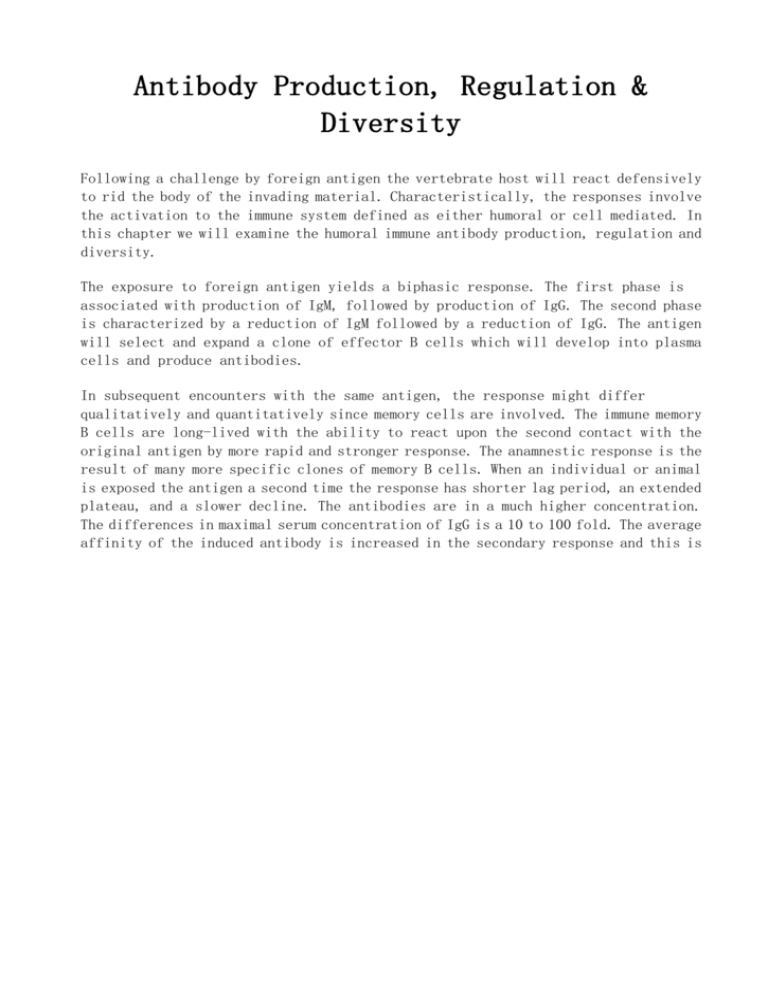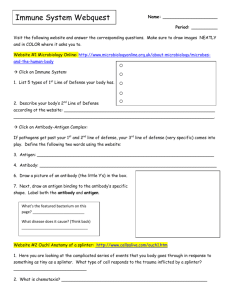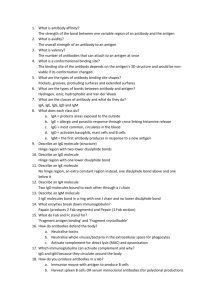Antibody Production, Regulation & Diversity
advertisement

Antibody Production, Regulation & Diversity Following a challenge by foreign antigen the vertebrate host will react defensively to rid the body of the invading material. Characteristically, the responses involve the activation to the immune system defined as either humoral or cell mediated. In this chapter we will examine the humoral immune antibody production, regulation and diversity. The exposure to foreign antigen yields a biphasic response. The first phase is associated with production of IgM, followed by production of IgG. The second phase is characterized by a reduction of IgM followed by a reduction of IgG. The antigen will select and expand a clone of effector B cells which will develop into plasma cells and produce antibodies. In subsequent encounters with the same antigen, the response might differ qualitatively and quantitatively since memory cells are involved. The immune memory B cells are long-lived with the ability to react upon the second contact with the original antigen by more rapid and stronger response. The anamnestic response is the result of many more specific clones of memory B cells. When an individual or animal is exposed the antigen a second time the response has shorter lag period, an extended plateau, and a slower decline. The antibodies are in a much higher concentration. The differences in maximal serum concentration of IgG is a 10 to 100 fold. The average affinity of the induced antibody is increased in the secondary response and this is know as affinity maturation. B cell precursors are derived from a stem cell. Through Ag-independent differentiation in a B cell environment, these cells acquire the competence to function a B cells. They migrate to secondary lymphoid organs, where they can differentiate into active B cells through ag-dependent differentiation. This leads to clones of plasma cells for each class of antibody. Memory cells can arise that will respond rapidly and more strongly upon subsequent encounter with same antigen. Antigen dependent differentiation proceed in two stages: (1) activation and (2) proliferation and differentiation. Antigen acts as specific signals that activate particular B cells. In addition, nonspecific signals are also provided by other cells to promote and modulate the differentiation of activated B cells. B cell activation by T-Independent Antigen T-independent antigen usually are polymeric, with repeating identical antigenic determinants (lipopolysaccharide) which degrade slowly. They can stimulate B cells directly by crosslinking surface receptors (IgG or TCR) for the antigen. The antigen interaction with membrane-bound surface antibodies triggers a cascade of reactions that produce change in the cell membrane, cytoplasm and nucleus. The membrane depolarizes leading to an influx of extracellular Ca ions. This, in turn, contributes to the activation of three membrane-associated response pathways: (1) stimulation guanylate cyclase with the production of cyclic quanosine monophosphate (cGMP), (2) activation of phospholipase C with the subsequent generation of Diacylglycerol (DAB) and inositol triposphate (ITP), and (3) activation phospholipase A2, which promote the metabolism of arachidonic acid (formation of protaglandins and leukotrienes). ITP, DAG, Ca and cGMP are substances that act as second messengers in the activation of several cellular systems. These factors are responsible for increasing the metabolic activity of the activated B cells. Specifically, these intracellular messengers activate protein kinases that promote the first steps of activation: (1) entry into B1 (2) production of interleukin 2 (Il-2) and other growth factors, (3) increased expression of IL-2 receptors (IL-2Rs) and increased expression for MHC Class II molecules. Passage into the S phase of the cell cycle, with subsequent DNA replication and cellular proliferation is apparently regulated by events mediated through IL-2Rs. Binding of antigens to specific receptors (antibodies) activates B cells. This triggers entry into the cell division cycle. Cytokines Il-1, Il-2, Il-4, Il-6 and IFNs) help promote this. Other cytokines, like IL-2 and BCFGs further promote cell division. This leads to clonal expansion of activated B cells. Cells that are induced to undergo terminal differentiation early by BCGFs undergo class switching early. These become antibody secreting plasma cells. Those that do not receive this signal early continue to repeat this divisional cycle. During each cycle , the opportunity exist to modify variable (V) regions through somatic mutation. Nonspecific antigen processing cells (APCs) take up antigen in the lymphoid centers like spleen or lymph nodes through a process called phagocytosis . The antigen becomes internalized and is processed. Different determinants are returned to the cell surface. Antigenic determinants are presented by the APC to THcells which in turn help stimulate the B cells divide and differentiate into clones of B cells. The displayed determinant are associated with major histocompatibility complex (MHC) class II antigens, and then presented to T lymphocytes by way of TCR. The APCs display antigens that possess two domains. The first is an epitope capable of binding to the paratope of TH cell receptor (TCR). The second is agrotope that is intimately associated with a class II MHC molecule. The TCR consist of transmembrane proteins that bind antigen. The TCR is noncovalently associated with five additional integral membrane proteins. The relative ability of each individual to respond to the antigenic universe is inherited to a large extent. Lymphocytes neither reproduce in uncontrolled fashion nor continuously produce increasing quantities of antibodies or lymphokines. A decline in functional expression follows primary and secondary immune responses. Hence specific immune responses must be down-regulated in some fashion. Several mechanisms operate to modulate immunological expression. Positive regulators include antigens and cytokines (IL-1, IL-2, BCGF, and BCDF) from macrophages and helper/inducer T Cells. Negative regulators include formed antibodies, immune complexes, suppresser factors (T suppresser cells) and Ig isiotype networks. Genetic Control Two broad categories of genes contribute to the control of immune responses. The first category of genes, receptor genes, controlling B and T cell receptors to a particular foreign antigen. The second category, immune response (Ir) genes, influence the quality and extent of the possible immune response. This category is composed of two types of genes. Ir genes either can be part of the MHC or be unrelated to it. Ir genes of the MHC, which encode class II molecules, primarily influence responses involving T helper cells and sensitized T delayed hypersensitivity cells, While those that encode class I molecules, principally control T suppresser and T cyotoxic cells. Non-MHC Ir genes appear to encode several products that might influence both arms of the immune response. There are numerous Ir gene loci (MHC and non-MHC) that influence the level of the immune response to any particular antigen. Ir MHC class II products are believed to act as the stage when Ag is processed. They influence cell interaction and the activation process. Malfunctioning class II MHC might not provide the proper signals for B cell activation for a normal humoral response. The humoral response is controlled, in part, by antibody production itself. This appears to be negative feedback regulation that is highly specific. The removal of blood from an immunized animal can stimulate antibody production. Passive immunization can suppress antibody formation to a certain antigen without effecting the response to other antigens. Antibodies can bind to antigen and prevent them from binding to receptors to T and B cells. Feedback regulation of antibody production Activation of B cells by antigen leads to production of antibody specific for those antigens. Antigen B stimulates the production of anti-B antibody. Subsequently, the antibody reduces the concentration of that antigen. This diminishes stimulation of further production of the specific antibody. Eventually, antigen B is completely removed and no further stimulation of the production of anti-B antibody occurs. These interactions, however, have no effect on the level of antigen A or its influence in stimulating anti-A antibody. Influence of immune complexes on immune responses Antigen characteristically triggers an immune response. An antigen that is complexed with antibody has differential effects on immune responses. At low Ab/Ag ratios, suppression of antibody production can occur. Under these conditions, immune complexes can bind to both mIg(ag) and FcRs (Ab) of the B cells. This suppresses antibody production. In contrast, at high Ab/Ag ratios, immune responses can be stimulated. This occurs through binding to FcRs on APCs that leads to activation of T helper Cells and subsequent enhancement of immune responses. Idiotype Network Antigen triggers antibody production. The antibody produced (Ab-1) not only react against the antigen, but they also serve as antigen themselves. This triggers the production of a second level of antibodies (Ab-2). In turn, these antibodies react against Ab-1 but serve to induce the anti-Ab-3 antibodies, and the process continues. At each step, the concentration of antibody available to provoke formation of an antibody is less than in the preceding step. As a result, a level is eventually reached at which there is insufficient antibody produced to provide and antigenic signal. Idiotype An idiotype consists of a set of epitopes associated with the V regions on the Ab antibody molecule. Each individual epitope is designated an idiotope. An idiotype is a set of epitopes displayed by the variable regions of a set of antibody molecules. Idiotopes can be associated with the paratope or lie outside it. Actions of anti-Id antibodies Antibodies against Ids that lie within a paratope can crosslink mIgs. In so doing, they can activate the affected B cell. On the other hand, antibodies against Ids lying outside a paratope can interact with mIg through their Fab region and with Fc receptors of the same B cell. In this configuration . Antibody production is suppressed. The result is tolerance. T and B cell activity can be regulated by T helper and T suppresser cells. Both cell types are stimulated during a normal immune response. They play a continuous homeostatic role in regulation of the response. T helper cells collaborate with B cells, providing the positive signals for T-dependent humoral responses. The T suppresser cells on the other hand provide negative signals. These signals limit or inhibit the development of antibody producing cells. T suppresser cells release suppresser factors (TsF) that promote most of the functions. For most suppresser cells there are no clear-cut MHC restrictions, as exist for T helper, cytotoxic and delayed hypersensitivity cells. The immune response is regulated by two major classes of factors; positive factors that promote the expression of cellular or humoral immunity and negative factors that diminish or suppress immunological expression. Antigen binding to mIg on B cells can induce activation. In addition, processed antigen by APC cells with the help of MHC and T cell receptor molecule can give a boost to the humoral response by stimulation of B cell proliferation and differentiation. The interaction between APC and T cells can ultimately suppress response by stimulation of T suppresser cells. Theory of Germline Gene Rearrangement When myeloma proteins were first sequenced, it became clear that both light (L) and heavy (H) chains varied markedly in their amino-terminal regions, but not in their carboxyl-terminal regions. It is hard to understand how a single gene might encode both V regions and C regions. It was proposed by Dreyer and Bennett that the V and C regions of antibody might be encoded by two different genes. This was the first speculation that genes might be split. They envisioned the possibility that many different B Germline genes existed and that any one of these might become associated with a single C region gene at the DNA level. They predicted that these antibodies genes were brought together during B cell differentiation. Their proposal became known as a recombinational germline theory. Continuation of Antibody Production Return This page is maintained by the Natural Toxins Research Center at Texas A&M University - Kingsville.







